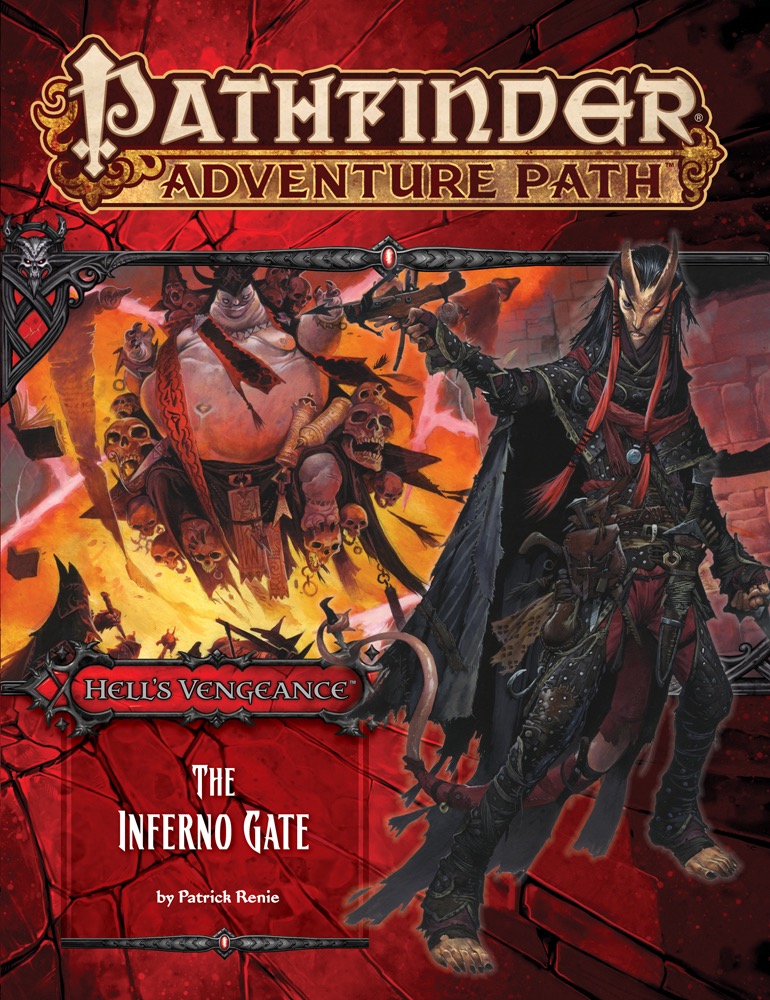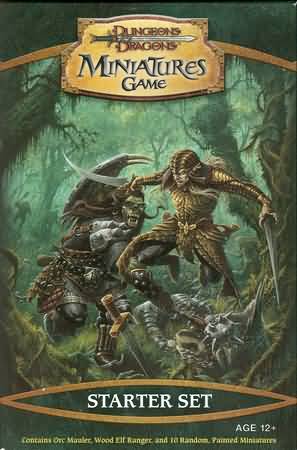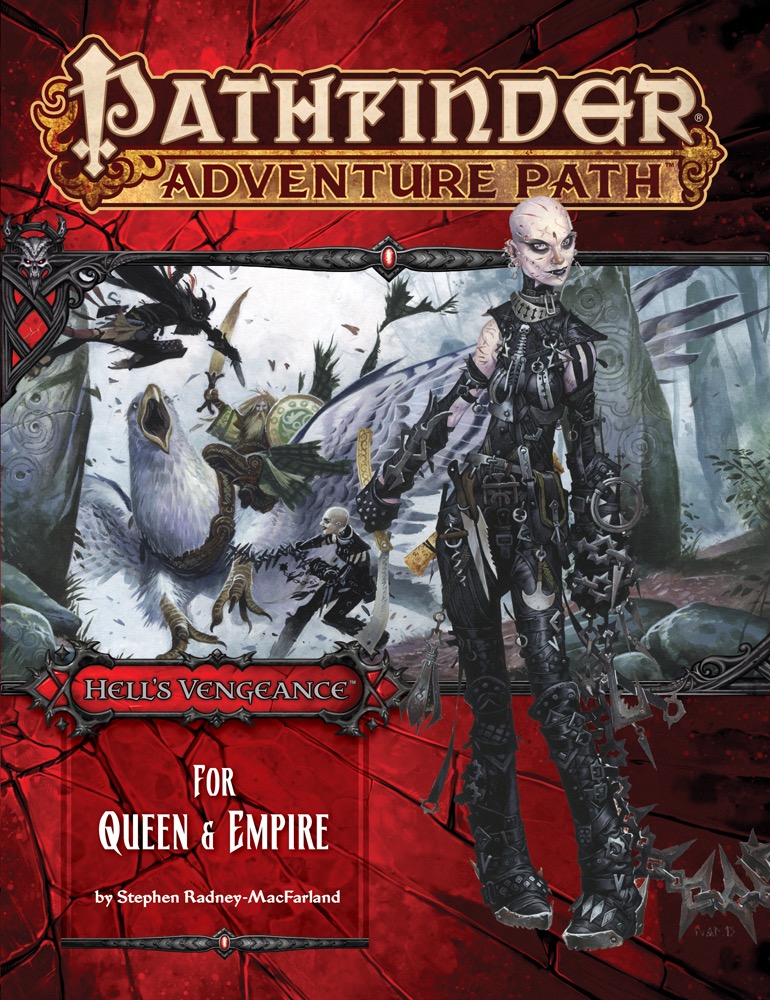Continuing my reviews of the Hell’s Vengeance adventure path, we come to books three and four, The Inferno Gate and For Queen & Empire. Here, I really headed down the path to madness.
SPOILER warning is in effect.
The Inferno Gate
In The Inferno Gate, the party heads to paladin-occupied Senara and then into the dark Whisperwood to find the Inferno Gate, a stable conduit into the Nine Hells that can be used to summon an army of devils. Of course, their boss Archbaron Fex backstabs them, and is in fact the final enemy of the book.
The thing about The Inferno Gate is that one chapter of the book is a hexcrawl. The problem with that hexcrawl, however, is that it does not adhere to Pathfinder’s rules about hexcrawls. The hexes in The Inferno Gate are 25-mile hexes, while the game rules assume 12-mile hexes. 25-mile hexes, incidentally, are larger than the city of New York. So, I’d just bought Campaign Cartographer off HumbleBundle, and I figured I’d redraw the map in the right scale.
The more mathematically inclined among you will see where this is going.
From 43 hexes, I went to around 200 hexes. I had to go to a print shop to get the map printed in A3 size. Of course, when one has around 160 more hexes than one started with, one needs to populate them. First, I emptied the random encounter tables from the module into the hexes. This helped a bit. Then I placed a couple of known landmarks from Cheliax, the Infernal Empire, and their surroundings, like the Pillar of Palamia, and constructed loose encounters around them.
Then I started getting desperate. I placed a few side trek encounters from Wizards.com, where you can still access their old 3E pages if you know where to look. In a fit of madness, I grabbed the old Fighting Fantasy book The Forest of Doom, mapped it out, and placed the encounters and subplot from that into my hexmap. I stole a chunk of Reverse Dungeon. In the end, I never populated the entire map, but I did do most of it, and then moved stuff around as the party explored the forest.
It did make The Inferno Gate very different from what it was, since most of the play time was spent in the forest – I think we had four complete sessions of that. Here, I also chose to fix what I perceive as the biggest shortcoming of Hell’s Vengeance. It’s missing one obvious adventure concept, the reverse dungeon. In my opinion, there should’ve been at least a chapter in one of the volumes where the party needs to defend a dungeon against encroaching paladins or whatever. So I did it here. For the final session of The Inferno Gate, after they’d slain the perfidious Archbaron Fex and claimed the Inferno Gate for their own, I broke out my old Dungeons & Dragons Miniatures rules.
Back when D&D Miniatures was a thing, I was an avid and active player. It also marks one of the few instances of a skill-based game where I was actually good on a competitive level. I still have my collection, and all the stat cards, so we calculated the commander stats for each member of the party, I whipped them up warbands and four enemy warbands – one was led by the Savage Mistress of Beasts, another was Glorious Revolution paladins, one I think was dwarves from The Forest of Doom, and one was just a bunch of do-gooder adventurers. The DDM Guild, a fan group keeping the game alive, was an invaluable resource in building the warbands.
Then I quickly taught my players the rules and we all played a couple of one-on-one matches, as the agents of Thrune summoned fiends from the Inferno Gate and defended Fort Arego against encroaching foes. Fun was had.
Arguably what I ran was not really The Inferno Gate, though most of its material did still survive to see the table. The thieves’ guild of Senara even killed Cimri Staelish. She was buried in a shallow grave at the edge of town. She did not feature in the campaign after that, though it was accepted among the group that she rose as some kind of vengeful undead.
Still, it’s hard for me to actually evaluate the text since my experience with it is so different. One thing I did not particularly like was the structuring of the final chapter, where first the party has to fight its way through a besieging force so that they themselves can assault Fort Arego, which feels a bit confused. Still, fun was had.

For Queen & Empire
This ended up being the shortest adventure in practice, and though I modified a lot, I did not add much. I did fix a major inconsistency that I perceived, however. At the start of For Queen & Empire, the House of Thrune calls all of their agents to Egorian to find someone who can do a major job for the Queen, but none of these other agents are featured in the module. If the agents have to queue for hours, as they do, the city would have to be teeming with high-ranking agents of Thrune. So, I added them in. The party ended up in the same inn with all the rest of the pre-generated characters from the adventure path, and kept running into colourful characters who were ostensibly on the same side. I tried to present Emil Kovkorin & co. as fellow agents who were going through exactly the same kind of crap that the party was.
In For Queen & Empire, the agents must navigate the intrigues of Egorian and pick a side from between two nobles vying for the Queen’s favour. The other one they must take into a grove in Barrowood and sacrifice to the Nine Hells to renew House Thrune’s contract. The contestants here are a duke whose wealth is based on breeding fiendish pigs, to whom he also feeds his enemies, and a countess whose husbands keep dying mysteriously. Also at the sacrifice there’s an end fight against a turncoat cleric of Asmodeus with no foreshadowing, which is a total asspull. Fortunately, as I described in the last post, I’d set up Lazzero Dalvera as the party’s foil, and could utilise him as a replacement.
Another thing I did was keep track of the calendar throughout the campaign, which bore some fruit in For Queen & Empire, as they ended up arriving in Egorian just in time for the last big gladiator tournament of the year, Dies Irae. They could not fight, of course, but they were invited to the stands by their other noble contact.
I like the setup of the adventure. The two NPCs are very juicy and interesting to roleplay, and the module also features one of the obligatory story beats for a villain campaign in Cheliax, crushing a cell of the Bellflower Network, which is basically a halfling underground railroad. However, I feel the adventure doesn’t lean enough into the courtly intrigue theme that’s right there and everything ends up being a fight. Go to a ball? There’s a fight. Sabotage a pig farm? There’s a fight. Try to prove the countess’s boyfriend is cheating on her? Dude’s also a high-level monk so I hope you put on your fighting trousers this morning. If I had had more time, I probably would have removed half the combat and rewritten the book as a more social adventure, but we were playing weekly at the time, and there are only so many hours in a day. Obviously, your mileage may vary and not every party is suited for it, but in my party, the lowest Charisma was 14.
For Queen & Empire has a solid core, but it feels like it doesn’t dare to venture too far from the combat-centred gameplay assumption, even though the game explicitly has tools and subsystems to handle courtly intrigue.



